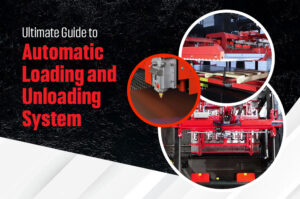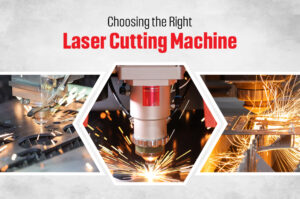Manufacturing companies need to mark products for identification and tracking, product branding, regulatory compliance, and product quality. The methods of marking products have undergone a series of development processes where traditional techniques of marking products have been replaced by modern technologies in marking products which tend to be precise, faster and more durable. Presently, laser marking machines have taken this evolution to various heights solving various industrial applications by being always accurate, permanent, and environmentally friendly. In this blog, you will learn how product marking has evolved through laser marking technology, the different types of laser marking machines, an overview of how the machines operate, and the various benefits of this emerging technology in the manufacturing industry.
The Traditional Product Marking Methods: Where It All Began
Before the use of laser marking; the conventional techniques in use included stamping, laser engraving, ink printing as well as a chemical etching procedure. These methods were as effective then as they are now, though they were frequently problematic in terms of sturdiness, accuracy, and expansibility.

Stamping and Engraving
Stamping involves pressing characters or designs onto a product’s surface, typically using metal stamps and force. While durable, it was labour-intensive and less suited to intricate designs.
Engraving, often done manually, required cutting or chiselling into the material. This method was time-consuming and struggled with scalability in high-volume manufacturing.
Ink Printing and Pad Printing
In the work of Bing, ink-based techniques such as pad printing were much easier and less expensive to produce markings. However, these markings were palpable to be faded or smudged in areas where several traffic intensities were observed.
Chemical Etching
In chemical etching, the surface would have to be attacked by the name of the chemical to create the markings. Although useful for metals, this method used dangerous chemicals – a problem for the employees and the earth as well.
The Limitations of Traditional Methods
Traditional marking methods had several disadvantages:
Durability: Some of the markings especially, those done in ink, wore out with time and became faint thus erasing the possibility of an easy read.
Precision: Processes such as stamping and manual engraving were not very detailed leading to loss of product uniformity.
Environmental Impact: Chemical etchings were sensitive to environmental management as they were cumbersome when disposing and this extended the environmental impact and also were expensive to use.
Speed and Scalability: The previous techniques were less effective when it came to environments that involved large scale production the scalability was poor.
When industrial needs changed, the need for a marking system that provided more accuracy, prolonged durability, and increased throughput paved the way for the development of laser marking technology.
The Advent of Laser Marking Technology: A Game-Changer in Product Marking
Laser marking technology shifted from physical or chemical marking processes to a new process that was non-contact, accurate and reliable. Compared to conventional techniques of marking, laser marking produces some benefits due to using a light beam to scribe the surface of a material.
How Laser Marking Works
Laser marking machines operate by focusing laser light on a substrate in order to create a mark. Depending on what operation is to be carried through, the laser changes the state of the material through either the heating-foaming process or the engraving-ablation process. Due to the adjustable settings in the machine, the laser can generate markings at different depths of contrast. This method is swift, and likely-once, able to provide optimum detailing on intricate patterns, smaller letters, numerals and micro printing as well.
Types of Laser Marking Machines in Manufacturing
There are various types of Laser marking machines which are developed to suit various sorts of materials and uses. Here’s a breakdown of the most common types:
Dynamic Fiber Laser Marking Machine
The fiber lasers are used in the marking of metals and certain kinds of plastics. They give very sharp and clear marks that are long-lasting and can’t easily be erased by rubbing since they’re created by concentrating a powerful beam on the surface area.
It is common to identify them in aerospace and automotive sectors where components have to work in a hostile environment and the labelling must be still clear.
Laser Engraving Machine
Laser engraving is the process of actually cutting many layers of material and giving a distinct look with depth. This make is right for an application where markings have to be extremely hard and durable like on jewellery, automotive, and tools.
Using laser engraving machine enables manufacturers to produce beautiful, detailed designs on several types of material.
Standard Laser Marking Machine
Conventional laser marking machine is universal and can mark almost any material from the metallic type to non-metallic including plastic and ceramics. Hence they are versatile for many industries such as electronics, medical and electronics products and gadgets, consumer products among others.
CO2 and UV Laser Marking Machines
CO2 lasers are commonly used in materials such as organic materials like wood, leather, glass and so on.
Fine detailed permanent marks can be achieved on sensitive materials such as glass and some transparent plastics using UV lasers.
Benefits of Laser Marking Machines Over Traditional Methods
Laser marking technology offers numerous advantages, addressing the limitations of older methods and enhancing manufacturing efficiency:
Durability and Resistance
Laser marks are non-erasable, and the method can withstand the treatment by chemicals, heat or friction, which makes the use of laser suitable for high wear applications.
High Precision and Detail
The laser marking is highly detailed, allowing information to be saved as micro-text, logos, and other designs of high quality replicated on different products. Such a level of accuracy is fundamental for compliance with the requirements of the current legislation.
Enhanced Efficiency and Scalability
Laser marking machines work at a very high rate and hence can be applied in automation systems of mass production.
Environmental Benefits
It is an additive manufacturing method Since no aggressive chemical is used during the process of laser marking it is clean technology. It does not use consumables such as ink or chemicals, thus owning less to the company and the environment.
Return on Investment (ROI): Why Laser Marking Machines Are Cost-Effective
From the results we derived, it is clear that once an organization buys laser marking machines, the long-term benefits largely offset the initial cost. Here are the main ways laser marking contributes to better ROI:
Reduced Consumable Costs: Laser marking does not require consumables as is the case for ink or for etching materials therefore laser marking is much more cost-effective over the long term.
Lower Maintenance: Since there are relatively few moving parts in a laser system, compared to more conventional marking systems, these systems are less prone to mechanical wear and therefore require minimum maintenance.
Improved Productivity: Fast marking rates cut down production time and help improve the number of products to be manufactured within a given period of time without a compromise on quality.
Decreased Waste: Precision marking reduces the percentage of mistakes made in the overall production process thereby reducing the amount of scrap that is produced.
Health and Safety Advantages of Laser Marking
The technology of utilizing laser marking machines is advantageous compared to chemical etching or employing manual engraving in that it is safe. Key health and safety benefits include:
Reduced Chemical Exposure: Laser marking, on the other hand, is a dry process which basically frees the etching process from dangerous chemicals and solvents.
Minimal Manual Intervention: As a result of laser marking automation, operators interact with the machine in a few aspects thereby minimizing contact with the machine and thus the probability of acquiring injuries such as those resulting from repetitive strain injury.
Maintenance and Best Practices for Laser Marking Machines
Maintenance, therefore, makes it possible to have the laser marking machines performing optimally all the time. Here are a few essential maintenance practices:
Clean Optics and Lens: The laser head should be cleaned from dust at least from time to time to ensure that the top quality of the laser and precise marking results are maintained.
Check Cooling Systems: Laser Marking Machines produce heat in the course of their operations. Having the cooling system work as supposed reduces the chances of overheating the machine thus increasing its durability.
Update Software Regularly: For controlling laser marking devices many devices come along with software controls. Updating software enables it to run with better performance as well as compatibility with the other automated systems in the production line.
Regulatory Compliance and Quality Standards
Laser marking may also be critical to enhance compliance with rules in countries such as aerospace, automotive, and medical device industries. Introduce: Very often, regulations demand that parts should have hallmarks that are recognizable and permanent with respect to traceability and safety.
Aerospace: In aerospace firms, rigorous specifications require the designation of the trace of every part. Laser markings also accommodate harsh environments to guarantee that the part will remain legible throughout its serviceability cycle.
Medical Devices: It’s important for medical devices to be compliant with regulatory requirements that mandate labelling with a UDI (Unique Device Identification) code to be placed on a medical device that meets definitional criteria, such that the encoded symbols are placed on a label that is permanent and biocompatible. This way laser marking helps to make these markings clear and to have the best possible shape and endurance.
Automotive: Electronic components for automobiles need to have permanent serial numbers for efficient tracking and identification of quality. Laser marking satisfies these requirements by producing clear, anti-corrosive marks.
The Future of Laser Marking Technology
In the future, laser marking machines will also develop and incorporate advanced technologies such as AI and IoT. These innovations will enable monitoring and early detection and eventual maintenance of production lines hence minimizing time wastage. Further, new technologies being developed are that lasers are being used to mark an even wider range of materials, faster and to higher levels of accuracy that are required in today’s manufacturing world.
Conclusion
The advancement from conventional methods of marking to laser marking machines has been a big boost in production. Current laser marking tools represent state-of-the-art in terms of accuracy, robustness and speed, which also makes it an essential tool in industries where quality and ability to track products are crucial. Through the use of laser marking solutions, manufacturers cannot only increase the quality of the product markings but also cut the long-term costs, boost safety and embrace sustainability. In this continually developing field of laser marking, those companies that implement these new technologies will be ahead of the competition and prepared to face the growing worldwide market challenges.















